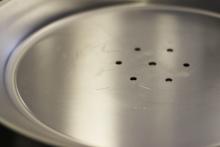Shaping sheet metal disks into axisymmetric and asymmetric parts without a mandrel.
| Key Features |
|
The Process
Sheet metal spinning is an ancient incremental forming process in which a disk that rotates on a lathe is worked progressively by a roller over an axisymmetric mandrel that sets the final shape. Traditionally used to make domestic products such as kitchenware and lampshades, in its modern version it is used to make automotive and aerospace components, as well as pressure tanks. Flexible spinning replaces the mandrel with a set of computer-controlled rollers. In this way, multiple component geometries can be formed without the need for specialised tools.
Key novelty and sustainability advantage
Compared to currently employed techniques (such as stamping and deep drawing), spinning is advantageous because of the smaller loads, lower setup times and lower capital investment. Moreover, spinning is a near net-shape process: it does not require additional material to form a part. Flexible spinning is even more advantageous because it removes the need for a mandrel, which results in considerable material savings. This results in a much higher material efficiency compared to current techniques.
Lines of research
Research on flexible spinning in the Use Less Group has three main aims. The first is to expand the capabilities of the process to make asymmetric shapes. Elliptical and square parts have already been demonstrated. The second is to find ways to control the process in a closed-loop. Additional sensors have been installed on the machine for this purpose. The third is to develop an automatic toolpath generation method. Recently, research on capturing the skill of experienced spinning artisans has been performed for this purpose.
History of the machine
The flexible metal spinning process was invented by Professor Allwood and former PhD student Omer Music. A patent has been granted for the invention. The machine was designed and built by Music and was inaugurated in 2011. In honour of its designer, it is also known as the Music Machine. Additional sensors, such as loadcells and a laser scanner line, were later added to implement closed-loop control. The machine can also be controlled manually using newly developed haptic controls that provide force feedback to the user. An industrial prototype of the machine was built by Primetals Technologies at the Manufacturing Technology Centre in Coventry, UK.

